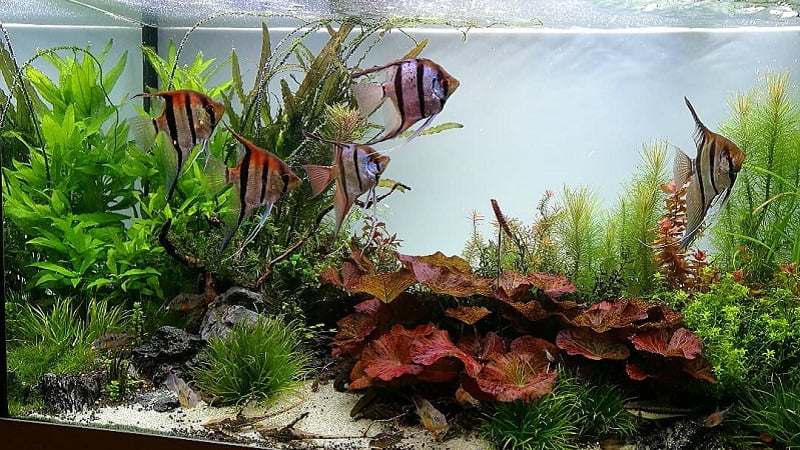The beautiful and elegant angelfish are very popular, and you can add liveliness to your aquarium with such stunning creatures. They are quite hardy and can adapt to a wide range of aquarium conditions.
As a rule, keeping fish in a tank environment that mimics their natural habitat is always recommended to maintain their health and activity levels. Many fish keepers prefer housing them in a planted aquarium since this type of tank gives them a sense of their natural habitat.
But what are the best aquarium plants that are most suitable for angelfish? This article will provide a list of 15 live aquatic plants that are best for an angelfish planted tank. Keep on reading to discover!
Related Articles
- Best Freshwater Angelfish Tank: Requirements, Setup Ideas & Basic Steps To Build
- What’s The Ideal Ph Level For Angelfish? Effects Of Ph Level
15 Best Live Plants For An Angelfish Planted Tank
Amazon Swords
- Scientific Name: Echinodorus grisebachii
- Origin: South America
- Height: Up to 24 inches
- Lighting needs: Moderate
- Care level: Moderate
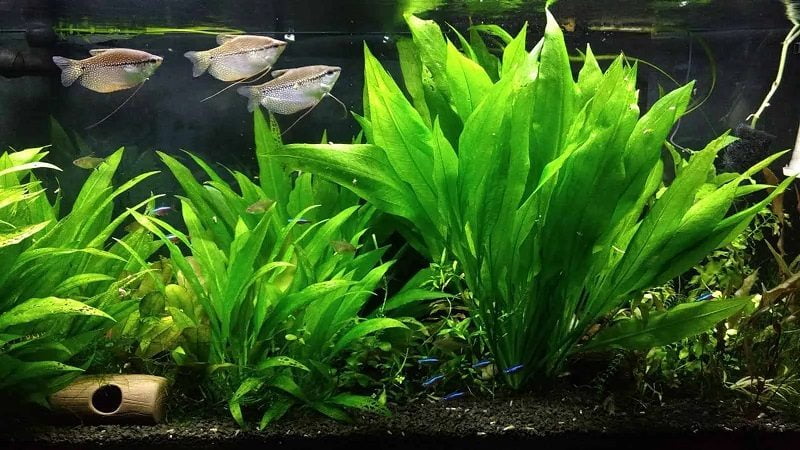
Since these plants are native to the shallows of the Amazon River, Amazon Sword plants should be included in every angelfish planted tank. They also have similar water conditions to your angelfish, which are soft, acidic water and temperatures about 80-86F.
There are dozens of varieties of Amazon Swords, and the largest can grow leaves up to nearly 2 feet in length. Thus, to ensure that your Amazon Sword plants don’t shade other plants in the tank, you should plan and arrange your aquarium carefully.
As the Amazon Sword are heavy feeders, mature and nutrient-enriched substrates are great choices. Especially for the red varieties of Amazon Sword, to keep their ruby color, the tank should have high lighting and extra iron supplementation.
Water Sprite
- Scientific Name: Ceratopteris thalictroides
- Origin: tropical regions in almost all the continents of the world
- Height: Up to 13.5 inches
- Lighting needs: Low to moderate
- Care level: Easy to moderate
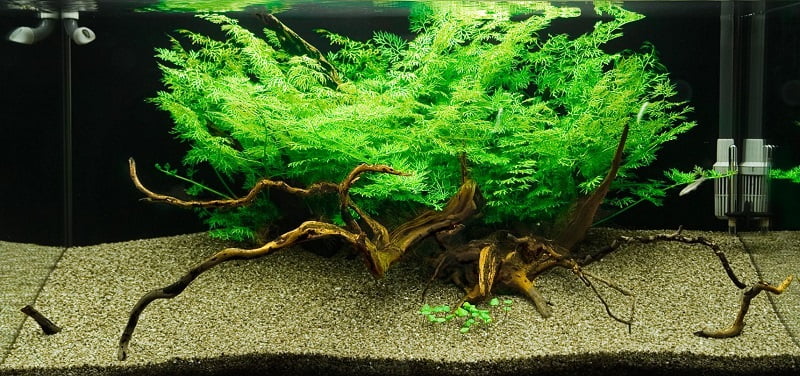
The reason Water Sprite is one of the best live plants for angelfish planted tanks is that it can become a dense and thick forest with many fine leaves. This is ideal for the angelfish to swim through, hide, get some privacy, and prepare to lay eggs.
It can grow up to 13 inches (33 cm) tall, so you can use it to make a great background plant for many types of aquariums.
Also, with the vibrant lace-like leaves, the water sprite can add an attractive and aesthetic vibe to your aquariums. Additionally, Water Sprite can be combined with plants of different colors to create a great contrast in the tank.
Water Sprite is also an essential plant for breeding angelfish. You can combine a bunch of Water Sprites with Amazon Swords, and your angelfish breeding pair will greatly appreciate this.
Java Fern
- Scientific Name: Bolbitis Heudelotii
- Origin: West Africa
- Height: Up to 10 inches
- Lighting needs: Low to moderate
- Care level: Very easy
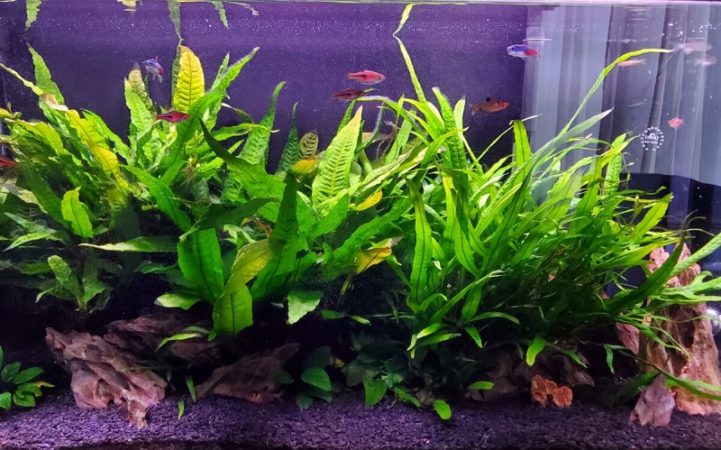
Java ferns provide angelfish with tall, textured leaves to swim around, and it requires low light and a little all-in-one fertilizer to develop. Because of its easy care, larger leaves, and slow growth rate, it is an excellent choice for new hobbyists.
For an angelfish planted tank, thin but sturdy leaves are ideal because the angelfish can lay eggs on these leaves. Besides, java fern has the bushy growth that helps provide great cover for your angelfish.
It is important to not bury the roots of your Java Fern if you do not want it to rot. You can consider attaching the plant to driftwood or a rock instead because this will fixate and weigh down the plant.
Jungle Vallisneria
- Scientific Name: Bolbitis Heudelotii
- Origin: Indigenous to North, Central, and South America, cultivated in US nurseries
- Height: Up to 6.5 feet (2 meters)
- Lighting needs: Moderate to high
- Care level: Easy
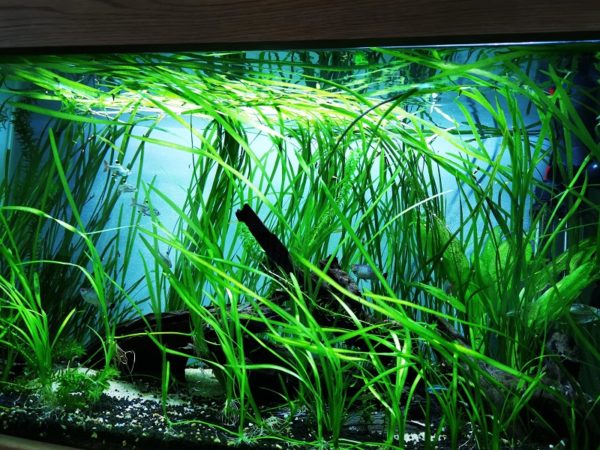
cre: @Little_Ambition on Reddit
Jungle Vallisneria is an aquatic species belonging to the family of tape grass plants. These plants can grow very high, up to several feet tall, providing a valuable shelter for shy fish and fry, and thus, such shy creatures will come into the open more frequently.
Jungle vals are hardy and can tolerate most types of water conditions. However, you should not trim its leaves since the damaged leaves will rot and fall off.
It is recommended to have the Jungle Vallisneria crowns planted above the substrate so that they can form strong roots, making it hard to be uprooted by bottom-dwelling fish or even the most aggressive fish. As a result, Jungle Vallisneria is suitable for herbivore and cichlid tanks.
Dwarf Tiger Lotus
- Scientific Name: Nymphaea zenkeri
- Origin: West Africa
- Height: Variable
- Lighting needs: Moderate
- Care level: Easy
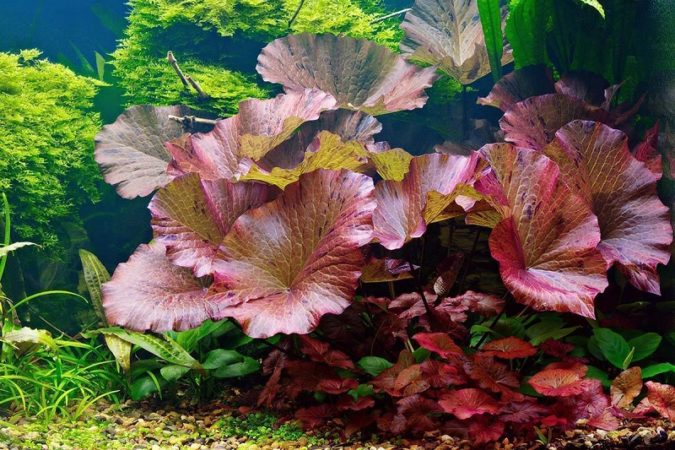
These plants are members of the Nymphaea genus, so they can grow submerged and floating leaves.
The leaves of Dwarf Tiger Lotus can grow up to 61 centimeters wide (2 feet). They can easily be maintained at smaller sizes, but they grow very quickly and need to be trimmed on a daily basis in some situations.
Additionally, in order to keep their bright colors, you should supplement them with iron and other fertilizers.
The main disadvantage of keeping Tiger Lotuses is that they shade out the water column beneath them, making it difficult to keep other plants that require more light.
Therefore, it’s best to grow Tiger Lotuses in an aquarium with very high light levels, or with plants that are less light-demanding, such as Anubias or Java Moss.
Water Wisteria
- Scientific Name: Hygrophila difformis
- Origin: South Asia
- Height: Up to 24 inches
- Lighting needs: Moderate to high
- Care level: Easy
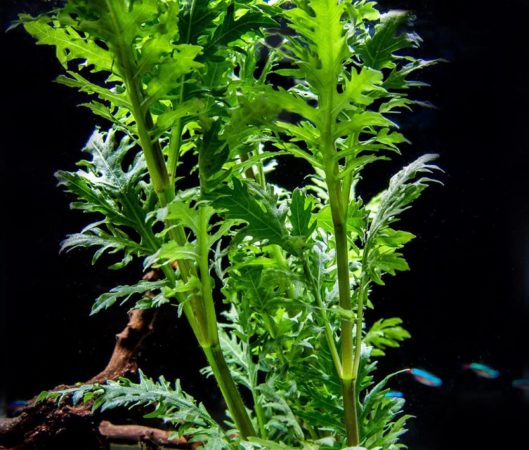
Water Wisteria can grow quickly and vigorously when being put in the right conditions. You can use it as a background plant for your angelfish planted tank, which can make your angelfish swimming through it more interesting.
It is easy to propagate this plant by simply trimming its tops and replanting them in the substrate. In nature, the plant grows so tall that parts of it break off, becoming new plants. So you just need to purchase a few stems, and overtime, you can get more of them.
Water Wisteria can be used to plant stem specimens, to make a carpeting plant, or be used as floating plants. It will grow wherever you place it, as long as you accommodate its preference for light and nutrients.
Healthy Water Wisteria has a striking lime green color and a relatively high growth rate. Although angelfish can’t spawn on these narrow leaves, their tank companions will enjoy the thickets this plant creates.
Hornwort
- Scientific Name: Ceratophyllum demersum
- Origin: Devonian
- Height: Up to 120 inches
- Lighting needs: Moderate to high
- Care level: Easy
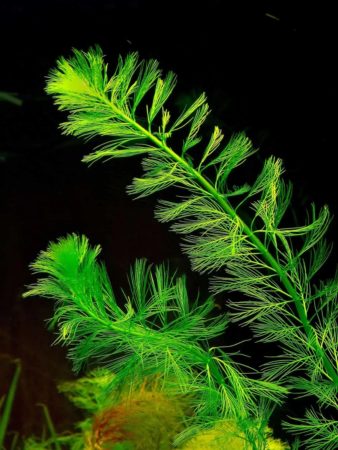
Hornwort is an easy and great plant to grow in an angelfish planted tank. Moreover, this plant is appropriate for a beginner-friendly tank. Growing this plant won’t be difficult if you use a bright light and plenty of liquid fertilizer.
You can grow it anywhere in the tank since it’s a very easy stem plant. This plant can grow very tall, so it would make a great background plant in an angelfish tank. It is also possible to grow them as midground plants when you trim them properly so that they do not grow all the way to the water surface of your tank.
Besides, you will notice that your angelfish will swim between the stems of Hornwort looking for cover if they are planted densely.
Dwarf Ambulia
- Scientific Name: Limnophila sessiliflora
- Origin: South-East Asia
- Height: Up to 50 cm tall
- Lighting needs: Moderate to high
- Care level: Easy
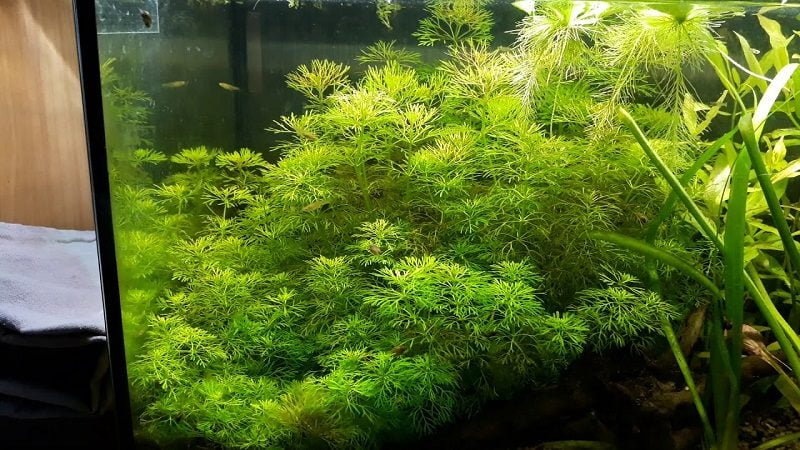
Dwarf Ambulia is a plant of the genus Limnophila that is highly appreciated in aquariums because of its size, striking green color, and ease of care in home aquariums.
These plants are ideal for placing at the bottom and middle of an Amazonian or tropical-style planted aquarium. Because of its bushy appearance, Ambulia can sometimes be placed in the middle of a tank.
Ambulias grow very fast, so adding liquid fertilizer is necessary to stimulate their rapid growth. Additionally, it will grow to the top of your tank and share some characteristics with Hornwort. However, because of its rapid growth, maintaining it as a background plant might be more difficult.
Water Lettuce
- Scientific Name: Pistia stratiotes
- Origin: Africa
- Height: 15 cm (6 in)
- Lighting needs: Moderate to high
- Care level: Easy
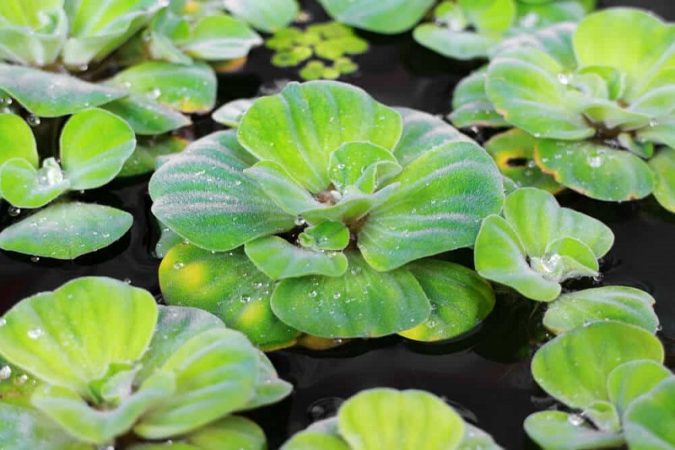
Water Lettuce are ideal floating aquatic plant for your angelfish planted tank. If you have an aquarium that provides enough height for your adult angelfish to comfortably swim around, adding floating plants can be a great idea.
Your angelfish will have a feeling of protection and safety with the Water Lettuce roots, as their roots can provide them with an experience similar to a blanket.
To ensure that water lettuce remains healthy, you need to keep three things in mind. A good aquarium light will provide enough lighting for your tank, liquid fertilizer will provide nutrients, and surface agitation should be kept to a minimum.
Like other floating plants, water lettuce do not prefer fast water currents, and like to be left alone to grow.
Anubias
- Scientific Name: Anubias
- Origin: Tropical central and western Africa
- Height: Various, depending on specific species
- Lighting needs: Low
- Care level: Easy
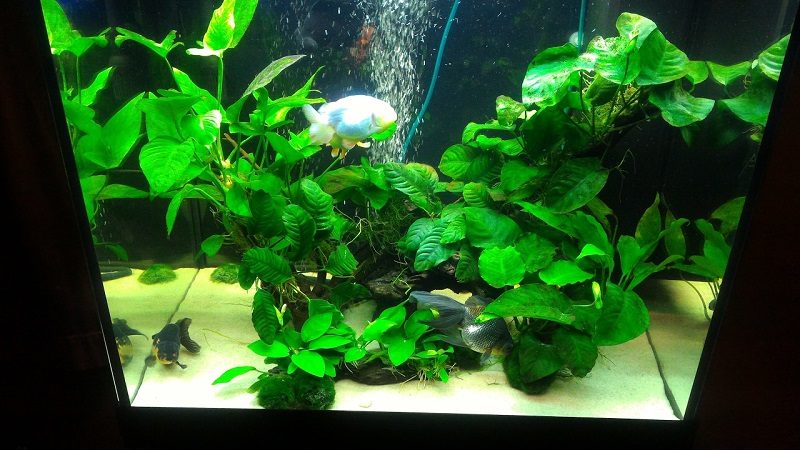
The most popular aquatic plants are all species of the genus Anubias. Their leaves are very suitable for angelfish to lay eggs on because they are thick and sturdy. However, the angelfish cannot swim through their thick leaves and stems, but this is not a problem. As they don’t grow very tall, they’re perfect for midground plants.
Unlike most plants, Anubias prefer low light, and they can also bloom underwater. You should place them in shaded areas, otherwise, algae will appear and grow on their leaves.
Anubias plants are excellent options for any aquarium. They are easy to maintain and do not require bright lights, additional CO2, or extra fertilizer. Moreover, they are available in many different sizes so you just need to choose one that fits your needs.
Dwarf Sagittaria
- Scientific Name: Sagittaria subulata
- Origin: Southern United States
- Height: 4-6 inches
- Lighting needs: Moderate to high
- Care level: Easy
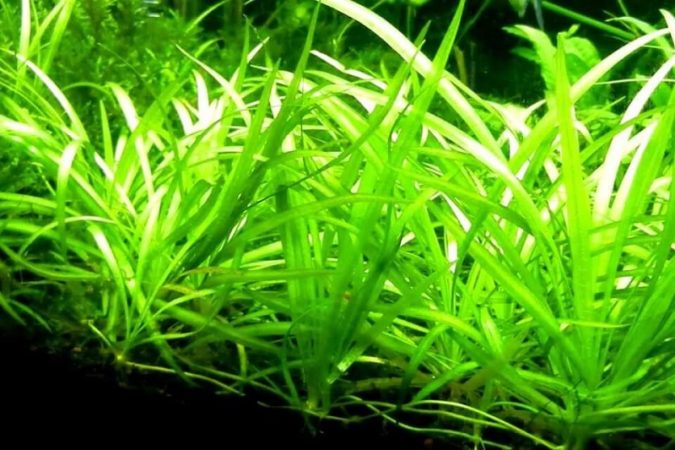
Dwarf Sagittaria is hardy, can adapt to a wide range of water conditions, and is suitable for beginners. As an amphibious plant, it grows both partially submerged and fully submerged.
The Dwarf Sagittaria can make excellent foreground plants if they are given bright lighting. In other words, to remain their small size, they need plenty of light; in some cases, they can grow taller to get more light. If this is the case, you can use them as excellent midground plants.
For planting Dwarf Sagittaria, the best way is to use aquarium soil enriched with nutrients or add some root tabs for more fertilizer.
Giant Hydro
- Scientific Name: Hygrophila corymbosa
- Origin: South America
- Height: Up to 20 inches
- Lighting needs: Moderate
- Care level: Easy
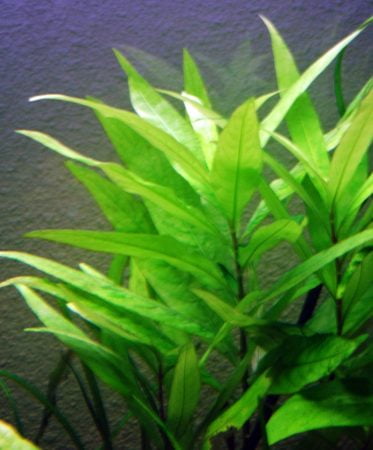
Hygrophila is sometimes called “swamp weed” because it tends to grow in swampy areas. They are great live plants for anglers as their water conditions are compatible with your beautiful fish: shallow, warm, acidic, and organic-rich conditions.
The Giant Hydro has long, broad, green leaves that can grow up to 5 inches long, making it one of the largest of the species. It is also easy to grow. Despite its moderate lighting needs, Giant Hydro is a low-maintenance plant that quickly takes root.
There is an important note for you when planting this aquatic species. Make sure you give enough space for its young specimens so that they don’t crowd each other as they grow.
Cryptocoryne wendtii
- Scientific Name: Cryptocoryne wendtii
- Origin: Sri Lanka
- Height: 8 inches
- Lighting needs: Low
- Care level: Very Easy
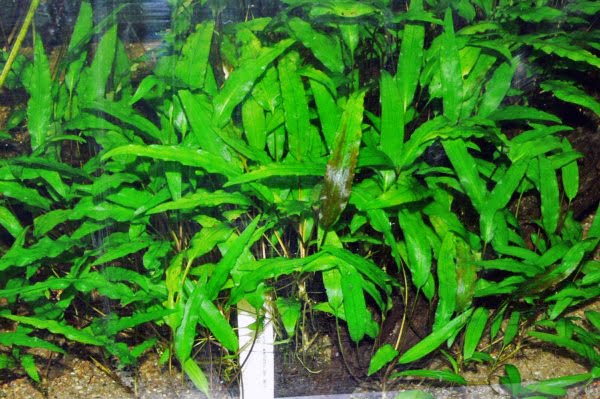
Crypts are among the best aquarium plants for beginners, and Cryptocoryne wendtii is one of the most suitable in the genus. Native to Sri Lanka, these plants have wavy spearpoint-shaped leaves and are usually green or bronze in color.
Cryptocoryne wendtii can survive in hard or soft water and in any light conditions. The plant prefers some fertilization and some CO2 supplementation, and its growth rate will be slower if these supplements are not provided.
Crypt leaves sometimes decompose all the way down to the rhizome. This plant also prefers consistency, which means they hate being moved around frequently or having water parameters changed rapidly. In such circumstances, it will become rooted and decay.
Most Cryptocoryne can make excellent plants for an angelfish planted tank. For example, the C. balansae can grow even taller, and the C. parva can be the most suitable carpeting plant for the low-light fish tank.
Madagascar Lace Plant
- Scientific Name: Aponogeton madagascariensis
- Origin: Madagascar
- Height: Up to 24 inches
- Lighting needs: Moderate to high
- Care level: Moderate to Difficult
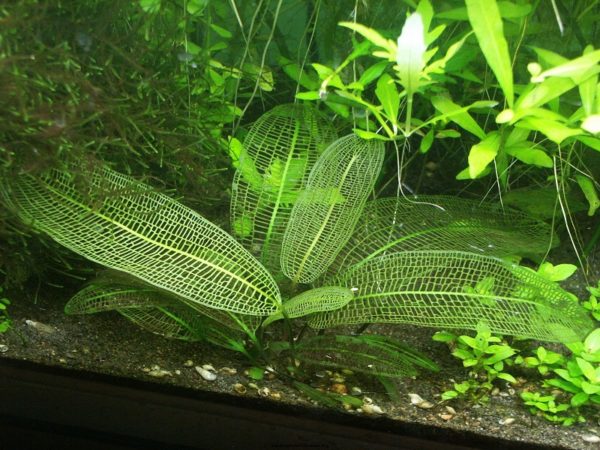
The Madagascar Lace Plant, often ranked with the Amazon Swords, is one of the most beautiful plants in the trade. Their leaves have intricate webbing, and they wave beautifully in slightly running currents.
The Lace Plant requires rich substrates, good lighting, and supplemental CO2. It is a show plant and thus needs space to grow up and out.
Though most Apogeton species require an emersed resting phase, meaning you have to trim the remaining leaves and take the bulb out of the tank for a seasonal resting phase for a few weeks, this is not the case for Madagascar Lace Plant.
Moneywort
- Scientific Name: Bacopa monnieri
- Origin: India & Southeast Asia
- Height: 10-12 inches
- Lighting needs: Low to Moderate
- Care level: Easy
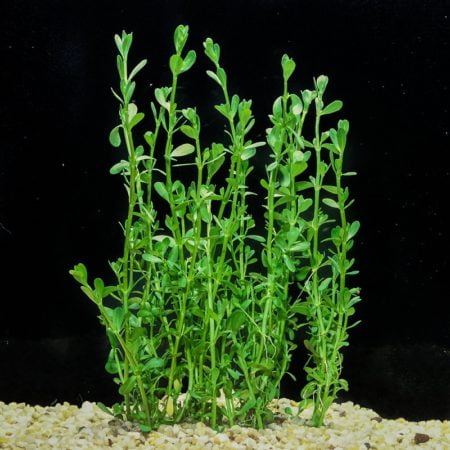
Moneywort, also known as Water Hyssop, is an aquarium plant that goes well with angelfish. In Indian traditional medicine, this plant is used to treat liver problems, diabetes, and several other ailments. It’s also an aquarium plant that goes well with Angelfish!
Moneywort is easy to care for and versatile. The plant grows both submerged and emersed and can thrive in low to medium-light aquariums. But, it is best to provide them with moderate lighting.
Although CO2 and fertilization aid its growth, they aren’t mandatory. Moneywort grows in the form of small thickets and has a nice, straight growth form.
The leaves and stems of moneywort are fragile and easily broken. However, it is possible to plant the stems, resulting in a brand new plant. Angelfish are a good choice for this plant because they display gentle behavior toward it.
The Best Substrate For An Angelfish Planted Tank
A large number of the above plants need to have their roots set in the substrate. Thus, it is essential to choose a suitable substrate for an angelfish planted tank.
Angelfish are cichlids, which may end up diving into the substrate every once in a while, so chunky gravel should be avoided.
The pebbles are not a good option since they are difficult to move aside due to their heaviness. Moreover, your angelfish can get hurt by the sharp edges on the pebbles.
As a result, you can consider aquarium sand or fine gravel with smooth edges. With either of these options, you can grow aquarium plants in a way that is safer and more tailored to the needs of angelfish.
To learn more about how to keep healthy live plants in angelfish tanks, you can check the following article: Planted Angelfish Tank Care Guide
Video: Planted Tank With Angelfish
FAQs
Do angelfish like algae?
Angelfish belong to the Pomacanthidae family and the members in this family are omnivores, meaning that they will eat both plants and animals. Most angelfish species, however, tend to be more herbivorous, and thus they like algae. Many like to eat macroalgae and filamentous algae, while others prefer microalgae and diatoms.
Do angelfish eat plants?
Occasionally, angelfish will nibble on plants, but they won’t eat them entirely. By feeding them other types of food, you can ensure they are well fed and get a complete diet, and they are likely to ignore the plants.
Do angelfish like heavily planted tanks?
The angelfish is reported to feed on plants, e.g. duckweed, thus there is a small risk that they will eat other aquarium plants, especially fine-leaved plants.
However, a planted tank works very well for keeping angelfish, as long as you are prepared to accommodate their special requirements.
Conclusion
Planted tanks are suitable for keeping angelfish since you can provide them with an environment similar to their natural habitat.
To help you choose suitable aquatic plants for your angelfish planted tanks, I have listed 15 popular plants that are favored by many aquarium hobbyists.
As the mentioned plants are mostly planted in the substrate, you should choose suitable substrate materials for your tank. Aquarium sand substrate can make the best solution for a hone planted tank.

Annette M. Chaney is an experienced marine biologist with over 20 years of experience as an aquarist and fishkeeper. She started her first aquarium at a young age, filling it with frogs and goldfish obtained from the ten-cent pet store.
Annette grew up caring for and breeding African Cichlids, which led to a hobby in high school that doubled as a profitable means. Attending Reed College gave her time to solidify herself as an accomplished aquarium caretaker with an eye for sales. After that, from 2009 – 2013, she studied at Roger Williams University – one of the most prestigious universities for Aquaculture and Aquarium in USA. She is the founder of AquariumCircle since 2010.
